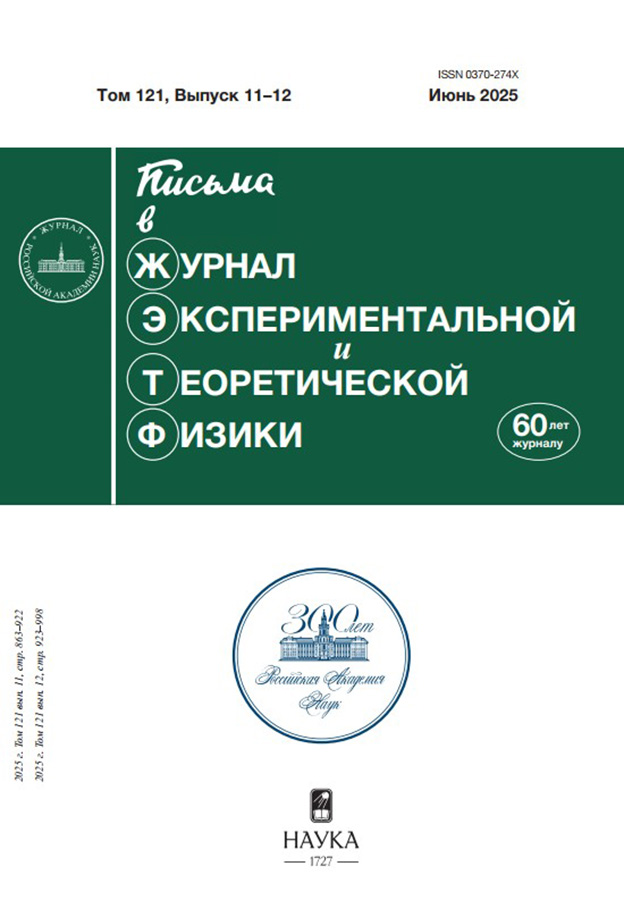Coulomb correlations and the electronic structure of bulk V2Te2O
- Authors: Skornyakov S.L.1, Trifonov I.O1, Anisimov V.I.1
-
Affiliations:
- Mikheev Institute of Metal Physics of Ural Branch of Russian Academy of Sciences
- Issue: Vol 120, No 7-8 (2024)
- Pages: 547-549
- Section: Articles
- URL: https://ruspoj.com/0370-274X/article/view/664352
- DOI: https://doi.org/10.31857/S0370274X24100106
- EDN: https://elibrary.ru/LJFFUX
- ID: 664352
Cite item
Abstract
The effect of Coulomb correlations on the electronic structure of bulk van der Waals material V2Te2O is studied by the charge self-consistent density functional theory and dynamical mean-field theory method. Our results show a significant correlation-induced renormalization of the spectral functions in the vicinity of the Fermi energy which is not accompanied by a transfer of the spectral weight to Hubbard bands. The computed quasiparticle effective mass enhancement m*/m for the V 3d states varies from 1.31 to 3.32 indicating an orbital-dependent nature of correlation effects and suggests an orbital-selective formation of local moments in the V 3d shell. We demonstrate that taking into account of Coulomb interaction between the V 3d electrons yields the electronic specific heat coefficient γ= 26.94mJK-2 mol-1 in reasonable agreement with the experiment. We show that the strength of Coulomb correlations is sufficient to trigger a band shift along the Z − Г − X path of the Brillouin zone leading to a collapse of the electronic Fermi surface pocket centered on the Г − Z direction predicted by density functional theory.
About the authors
S. L. Skornyakov
Mikheev Institute of Metal Physics of Ural Branch of Russian Academy of Sciences
Email: skornyakov@imp.uran.ru
Yekaterinburg, Russia
I. O Trifonov
Mikheev Institute of Metal Physics of Ural Branch of Russian Academy of Sciences
Email: skornyakov@imp.uran.ru
Yekaterinburg, Russia
V. I. Anisimov
Mikheev Institute of Metal Physics of Ural Branch of Russian Academy of Sciences
Author for correspondence.
Email: skornyakov@imp.uran.ru
Yekaterinburg, Russia
References
- S. Z. Butler, S. M. Hollen, L. Cao et al. (Collaboration), ACS Nano 7, 2898 (2013).
- K. S. Novoselov, V. I. Falko, L. Colombo, P. R. Gellert, M. G. Schwab, and K. Kim, Nature 490, 192 (2012).
- R. M. Fernandes, A. I. Coldea, H. Ding, I. R. Fisher, P. J. Hirschfeld, and G. Kotliar, Nature 601, 35 (2022).
- J. A. Wilson and A. D. Yoffe, Adv. Phys. 18, 193 (1969).
- T. F. Smith, R. N. Shelton, and R. E. Schwall, J. Phys. F: Met. Phys. 5, 1713 (1975).
- C. B. Scruby, P. M. Williams, and G. S. Parry, Philos. Mag. 31, 255 (1975).
- I. Guillam´on, H. Suderow, S. Vieira, L. Cario, P. Diener, and P. Rodi´ere, Phys. Rev. Lett. 101, 166407 (2008).
- S. Koley, N. Mohanta, and A. Taraphder, Eur. Phys. J. B 93, 77 (2020).
- A. Ablimit, Y.-L. Sun, E.-J. Cheng, Ya-B. Liu, S.-Q. Wu, H. Jiang, Z. Ren, S. Li, and G.-H. Cao, Inorg. Chem. 57, 14617 (2018).
- H. Lin, J. Si, X. Zhu, K. Cai, H. Li, L. Kong, X. Yu, and H.-H. Wen, Phys. Rev. B 98, 075132 (2018).
- S. Manzeli, D. Ovchinnikov, D. Pasquier, O. V. Yazyev, and A. Kis, Nat. Rev. Mater. 2, 17033 (2017).
- G. H. Han, D. L. Duong, D. H. Keum, S. J. Yun, and Y. H. Lee, Chem. Rev. 118, 6297 (2018).
- M. Valldor, P. Merz, Y. Prots, and W. Schnelle, Eur. J. Inorg. Chem. 2016, 23 (2016).
- A. Georges, G. Kotliar, W. Krauth, and M. J. Rozen- berg, Rev. Mod. Phys. 68, 13 (1996).
- H. Park, A. J. Millis, and C. A. Marianetti, Phys. Rev. B 90, 235103 (2014).
- M. V. Sadovskii, Phys.-Uspekhi 51, 1201 (2008).
- M. Aichhorn, L. Pourovskii, V. Vildosola, M. Ferrero, O. Parcollet, T. Miyake, A. Georges, and S. Biermann, Phys. Rev. B 80, 085101 (2009).
- S. L. Skornyakov, V. I. Anisimov, and D. Vollhardt, Phys. Rev. B 86, 125124 (2012).
- S. L. Skornyakov and I. Leonov, Phys. Rev. B 100, 235123 (2019).
- L. V. Pourovskii, G. Kotliar, M. I. Katsnelson, and A. I. Lichtenstein, Phys. Rev. B 75, 235107 (2007).
- S. L. Skornyakov, N. A. Skorikov, A. V. Lukoyanov, A. O. Shorikov, and V. I. Anisimov, Phys. Rev. B 81, 174522 (2010).
- S. L. Skornyakov, D. Y. Novoselov, T. Gu¨rel, and V. I. Anisimov, JETP Lett. 96, 118 (2012).
Supplementary files











